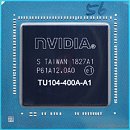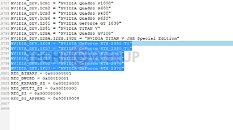Sunday, May 5th 2019

NVIDIA To Stop Differentiation of Better Binned A-dies for AIB Factory Overclocked Cards
A report from Tom's Hardware.de claims that multiple industry sources have confirmed that NVIDIA will stop offering higher-binned, differentiated A-dies of their Turing silicon. If you'll remember, the company introduced specific A-binned chips for AIB partners to ship with factory overclocks to customers, due to their higher overclockability - and likely, better power consumption profile - when compared to non A-binned dies. This practice was reserved to the company's best, though, in the form of the TU104-400A-A1 die (compared to the TU104-400-A1 dies used in non-overclocked versions of AIB graphics cards). The company is now seemingly killing this practice by offering a one-off Turing die with no such limitations.
This move by NVIDIA - on which we reported firsthand here at TPU - was likely a solution to somewhat less than ideal yields for its TU-104 chips, ensuring partners could provide the best experience to users who were willing to pay the most. The fact of the matter is that AIB partners were locked out of overclocking non-A dies should they acquire them (which were going for less than their higher-binned A-cousins), though the end-user would not see such a limitation - besides the one imposed by the expectedly less capable dies present on those non factory-OC'd cards.
Source:
Tom's Hardware.de
This move by NVIDIA - on which we reported firsthand here at TPU - was likely a solution to somewhat less than ideal yields for its TU-104 chips, ensuring partners could provide the best experience to users who were willing to pay the most. The fact of the matter is that AIB partners were locked out of overclocking non-A dies should they acquire them (which were going for less than their higher-binned A-cousins), though the end-user would not see such a limitation - besides the one imposed by the expectedly less capable dies present on those non factory-OC'd cards.


20 Comments on NVIDIA To Stop Differentiation of Better Binned A-dies for AIB Factory Overclocked Cards
Now everyone has the same chance of buying a dud, or winning the silicon lottery.
I prefer the idea of buying a better chip if I want to overclock, and it shouldn't matter what brand.
NVIDIAs fault surely. Too many A dies. ;)
You can really expect more of this regardless of competition as the nodes get smaller and the performance wins get smaller per release. Its only positive that yields are now good enough to get these large chips to a more consistent level. Because what this really means in practice, is that those lower priced AIB models now *might* have a few more clock bins to play with.
as for the enthusiasts this move only simplified.
vs
No more A SKU and every 2080 selling at $799
Which one?
Now, they're going back to the traditional way, and everyone is playing the silicon lottery. How terrible?
I'm forever thankful the word scandal didnt make it into the title. :)
But if they are going to stop binning, I don't see them tossing the ones that OC well .. and only keeping the class that doesn't ... if yields always improve over time so in the normal curse of events, it should be the slower ones that we stop seeing.